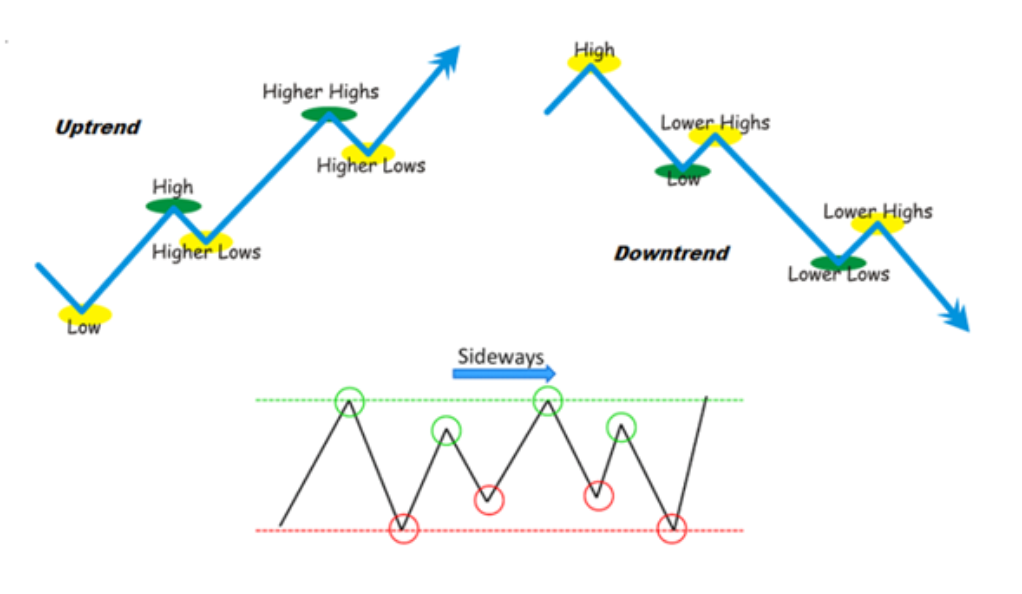Ever wondered how some investors always seem to have their finger on the pulse of the market? It’s not magic. It’s understanding and decoding market trends.
Defining a Market Trend
In essence, a market trend is the general direction in which the market is moving over a specific period of time. It’s like the wind – you can’t see it, but you can definitely feel its effects.
Types of Market Trends

Typically, there are three main types:
- Uptrend: When the market is climbing upwards.
- Downtrend: A phase when prices are falling.
- Sideways/Horizontal Trend: When the market is neither rising nor falling.
Importance of Spotting Market Trends
In the vast, tumultuous world of investments, the ability to identify market trends stands as a beacon for astute investors. It can be the difference between seizing golden opportunities and succumbing to perilous pitfalls. Let’s break down why it’s crucial:
The Power of Timeliness in Investment
- Navigating the Investment Landscape:
When you spot a market trend early, you are essentially reading the map of the investment world. You gain a clearer understanding of where the opportunities lie and which paths to avoid. - Seizing Opportunities:
An early recognition of an uptrend offers investors a competitive advantage. Think about it. Being an early investor in Apple or Amazon was not just about luck. It was about recognizing potential based on market trends. Those who took the leap, trusting the emerging trends, enjoyed exponential returns on their investments. - Compounded Growth:
Early investments, especially in stocks or assets that grow over time, can lead to compounded returns. This means the sooner you get in, the more time your investment has to grow and build upon its own gains.

The Shield Against Potential Pitfalls
- The Cost of Ignorance:
Not being aware of or ignoring market downtrends can be detrimental. When the dotcom bubble burst, many found their investments sinking. Those who had recognized the negative trend early on would have had the foresight to pull out or diversify, protecting their assets. - Proactive vs. Reactive:
Spotting a downtrend early allows investors to be proactive. Instead of reacting to losses, they can strategize on how best to minimize risks. This might involve hedging, diversifying, or reallocating resources. - Emotional Stability:
Investments aren’t just about numbers; they’re intertwined with emotions. Watching your hard-earned money lose value can be heart-wrenching. Recognizing a downtrend early can provide an emotional respite, as you’re better prepared to handle market downturns, knowing they were a possibility.
Tools for Identifying Trends
In the intricate maze of investments, being able to determine where the market is headed can give you a significant edge. Just as a meteorologist uses tools to predict the weather, investors leverage specific tools to predict market movements. Let’s take a closer look at these essential instruments.
Technical Analysis
- Charting the Path:
At the heart of technical analysis lies the study of price charts. These charts graphically represent an asset’s historical price data over varying time frames. By scrutinizing these charts, investors can identify patterns that suggest future price movements. - Indicators and Oscillators:
Beyond basic charting, technical analysts employ various indicators like the Moving Average, Relative Strength Index (RSI), and the MACD (Moving Average Convergence Divergence). These tools help identify momentum, trends, and potential buy or sell signals in the market. - Volume Analysis:
Volume, or the number of shares traded, is another critical factor. A sudden spike in volume might indicate a strong interest in a particular asset and can often precede significant price movements. - Support and Resistance:
These are price levels where a stock tends to find a resting ground. A ‘support’ level indicates a price at which a stock or market finds it difficult to fall below, while ‘resistance’ is a price point the asset struggles to surpass.

Fundamental Analysis
- Balance Sheets and Income Statements:
A company’s financial statements offer invaluable insights into its health. Analyzing assets, liabilities, revenues, and expenses can help determine if a company is undervalued or overpriced. - Economic Indicators:
Fundamental analysts also consider broader economic factors. Indicators such as GDP growth, unemployment rates, and interest rates can provide clues about the health of the overall economy, which in turn can influence market trends. - Industry and Competitive Analysis:
How is the company faring compared to its competitors? Is it a leader or a laggard in its industry? Understanding a company’s position within its sector can provide additional context about its potential for growth. - Management and Strategy:
A company’s leadership and its future strategies play a vital role. Investors often look into the track record of a company’s management team and their future vision to gauge potential success.
Steps to Capitalize on Market Trends
Understanding market trends is half the battle; the other half is leveraging this knowledge to your advantage. Spotting a trend is akin to finding a trail in the wilderness. But how do you ensure this trail leads to investment success? Let’s explore:
Recognize the Trend Early
- Foreseeing Opportunities: Just as a surfer tries to catch a wave at its onset, in the investment realm, identifying a trend early can position you to ride the wave of opportunity to its fullest potential.
- Research and Confirmation: While it’s beneficial to detect trends early, it’s equally crucial to validate them. This involves researching the factors driving the trend and ensuring it’s not just a short-lived anomaly.
Diversify Your Investments
- Spread the Risk: Just as travelers would pack both sunblock and an umbrella irrespective of the forecast, diversifying your investments ensures you’re prepared for multiple market scenarios.
- Exploring Different Avenues: Consider spreading your investments across various asset classes, industries, and even geographic regions. This way, if one sector underperforms, another might offset those losses.
Monitor and Adjust
- Stay Informed: Like a ship’s captain constantly checks the radar for changes in weather, regularly review your investment portfolio. Stay updated with financial news, quarterly reports, and market indices.
- Adaptability: Markets evolve, and what was a rising trend yesterday might not be today. Being flexible and willing to reallocate assets based on changing trends can be a game-changer.
Mistakes to Avoid
- Resisting the Herd: It’s human nature to follow the crowd, but in investing, the herd doesn’t always know best. Blindly following popular opinion can sometimes lead you off a cliff.
- Emotional Detachment: Investments can stir up a whirlwind of emotions, from the excitement of gains to the dread of losses. However, letting emotions dictate your investment decisions can cloud judgment. Approach investing with a clear, rational mindset.
The Future of Investment and Market Trends
The world of investment is evolving, with AI and machine learning playing a more significant role. But one thing remains constant: the importance of understanding market trends.
Conclusion
Decoding market trends is an art and a science. With the right tools, mindset, and approach, you can spot and capitalize on numerous investment opportunities. So, are you ready to catch the next big wave?
FAQs
Start with basic financial literature and consider taking courses in technical and fundamental analysis.
While trends can give insights, they’re not foolproof. Always diversify and do thorough research.
While they’re powerful tools, human intuition and understanding remain crucial in investment decisions.
It depends on your investment style. Active traders might monitor daily, while long-term investors might check weekly or monthly.
No, but it can significantly increase your chances of making informed decisions.
Investdigital is committed to delivering unbiased and reliable information on subjects like cryptocurrency, finance, trading, and stocks. It's crucial to understand that we do not possess the capability to offer financial advice, and we actively encourage users to conduct their own comprehensive research.
Read More

